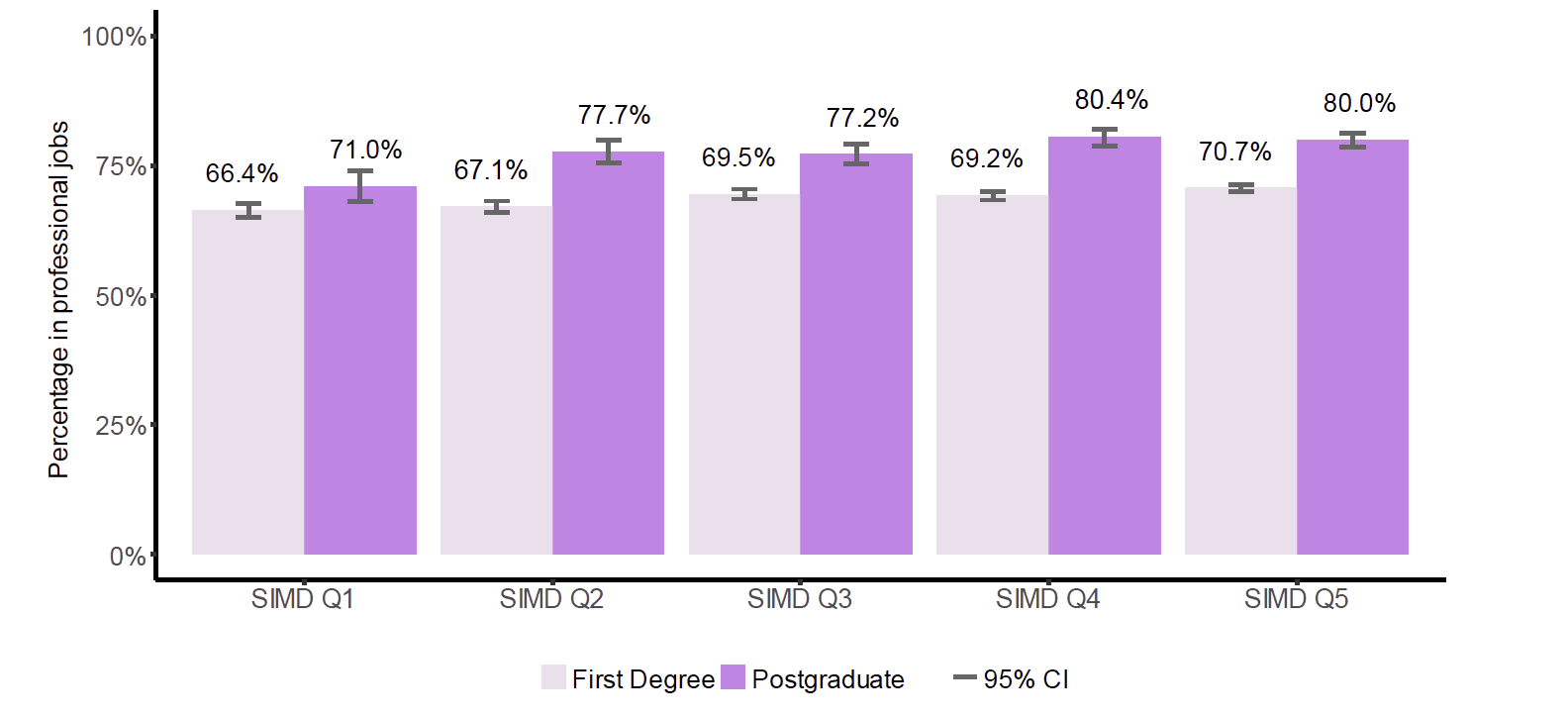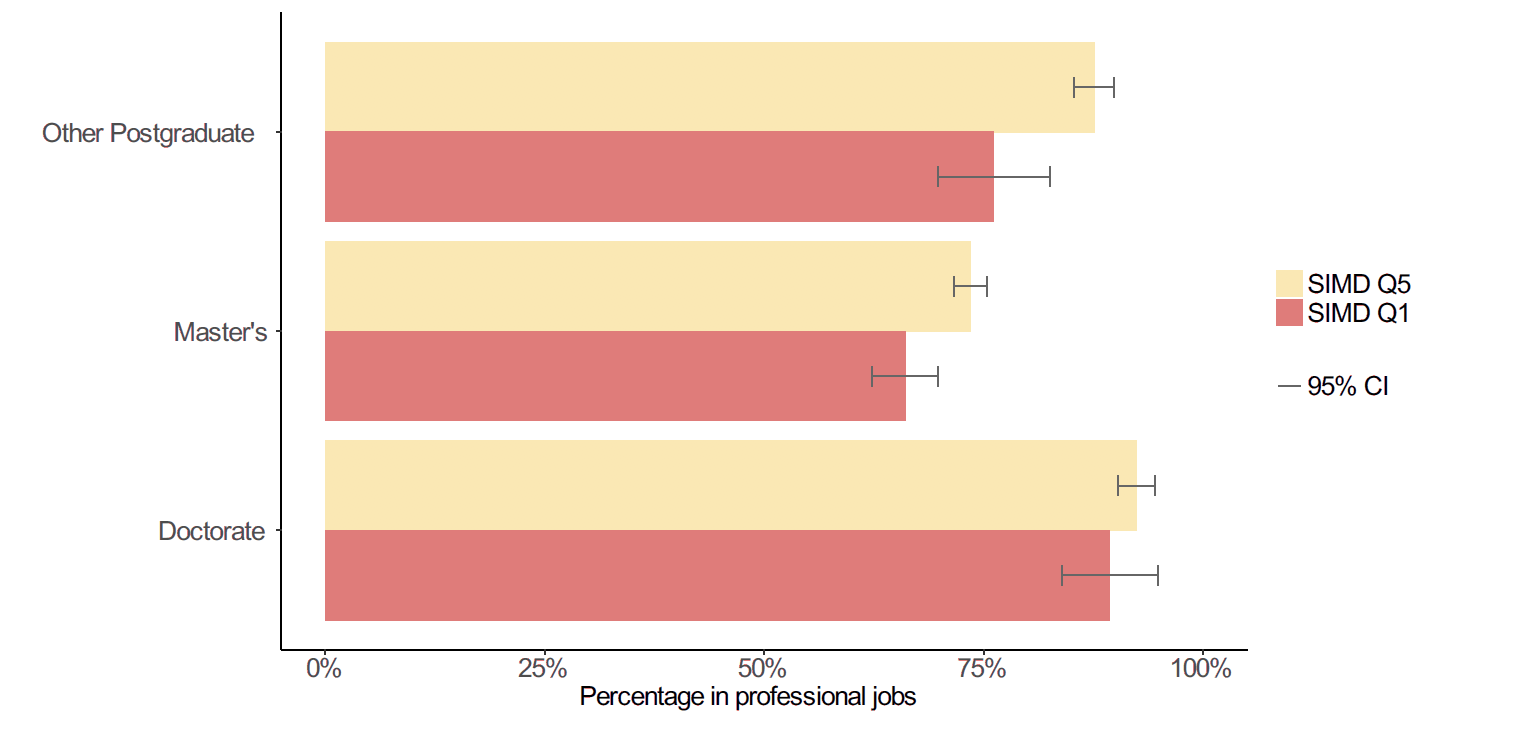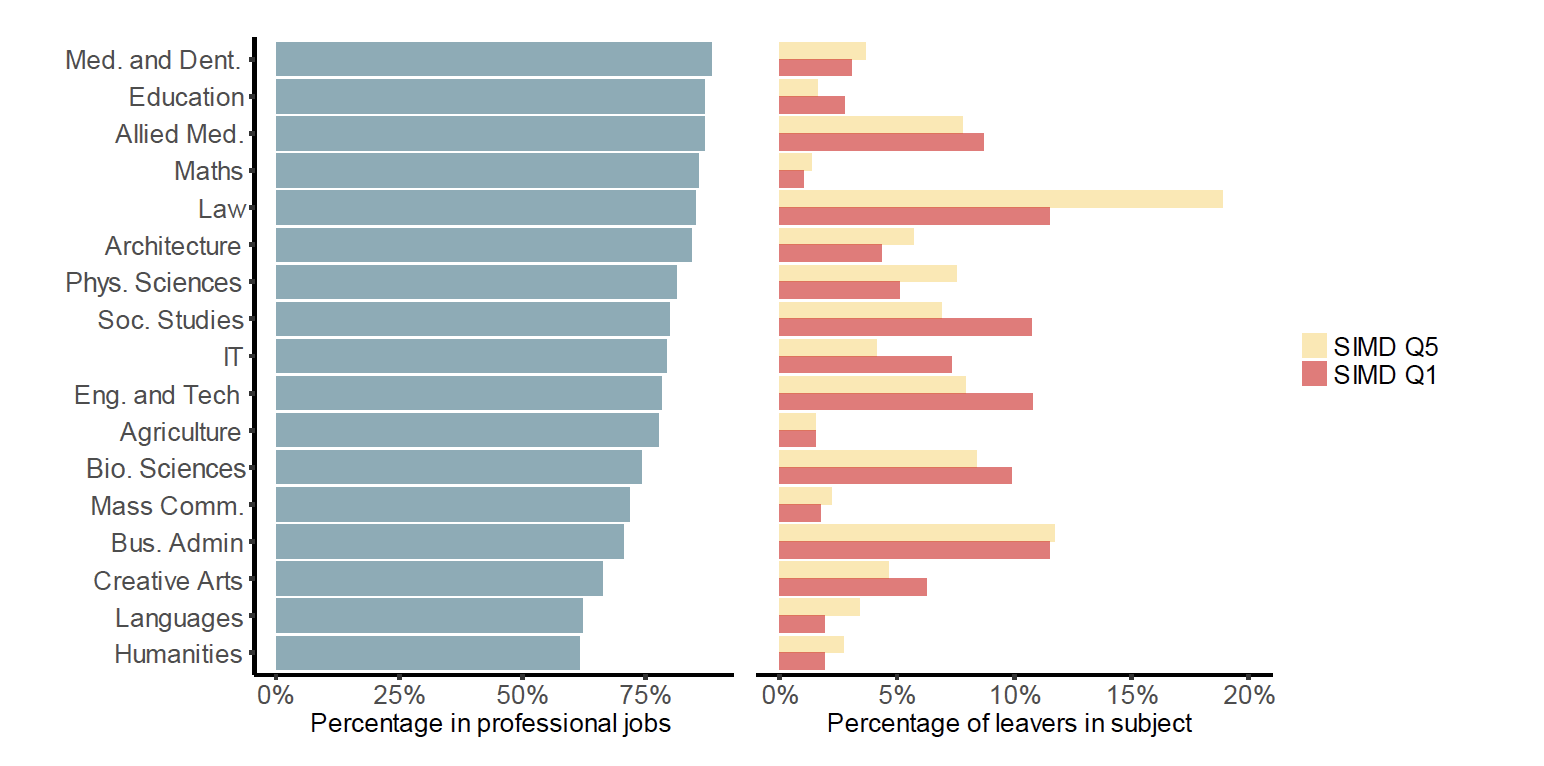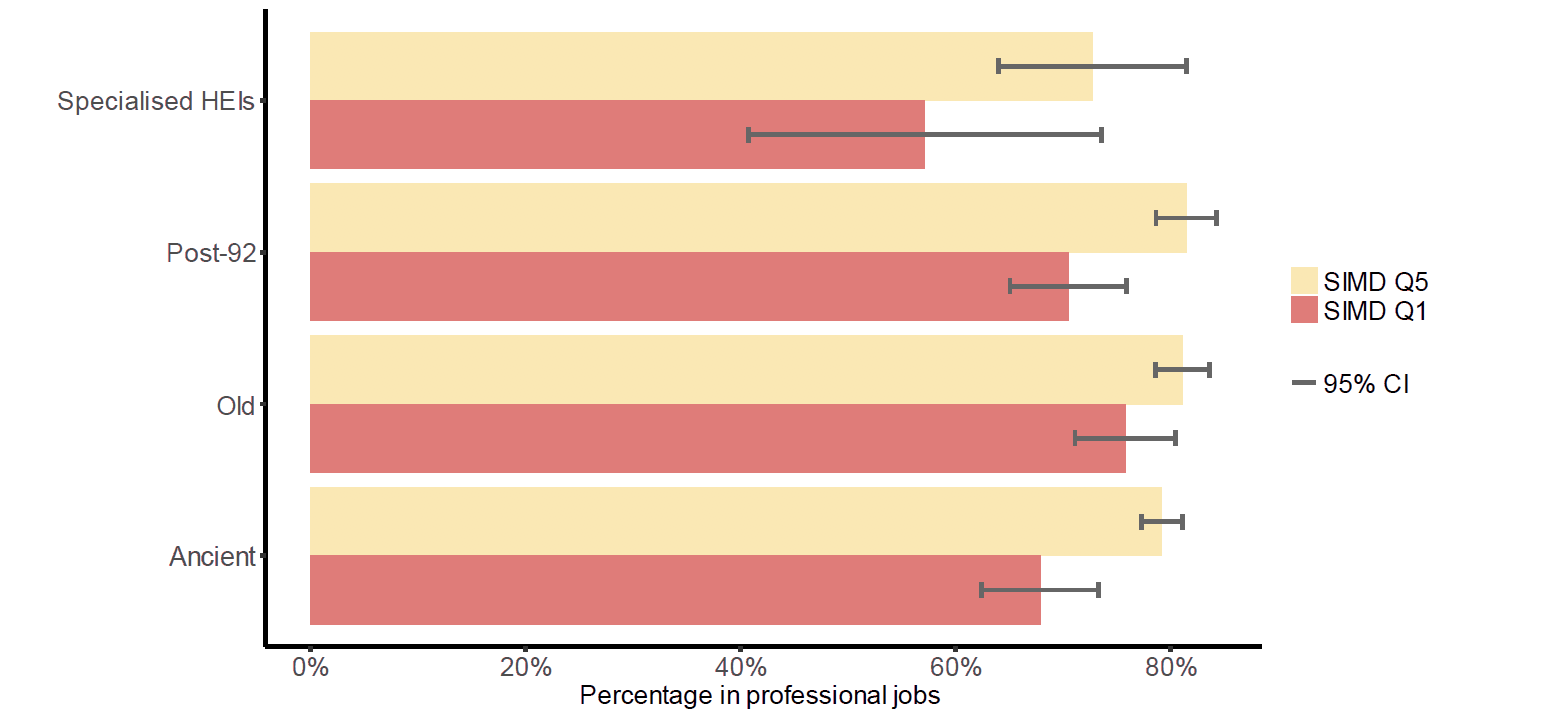Access to postgraduate study - representation and destinations: discussion paper
Independent paper from the Commissioner for Fair Access considering representation of students from the most deprived areas of Scotland in postgraduate study and their destinations.
Postgraduate destinations
Postgraduate leavers considered in this analysis include only Scottish domiciled leavers who were active in the labour market (their primary activity was work or looking for work), six months after leaving university as recorded in the DLHE. The percentage in professional (or managerial) level occupations[11] was then measured, using the Standard Occupation Classification 2010 (SOC 2010) produced by the Office for National Statistics. This is a useful proxy for 'graduate-level' occupations, is in line with HESA and Scottish Funding Council (SFC) definitions, and follows the definition adopted in a previous discussion paper. Only full-time students are considered for the destinations analysis in order to focus on employment acquired following postgraduate study (since part-time students often undertake study alongside employment). Postgraduate leavers from PGDE courses have been excluded, since the Teacher Induction Scheme guarantees a one-year teaching post in Scotland upon qualification (resulting in over 99% of PGDE leavers in a professional level job six months after graduation).
Figure 7: Percentage of full-time leavers in professional level jobs (six months after leaving), by SIMD quintile
Source: HESA DLHE data (2013/14 to 2016/17)

Figure 7 shows the percentage of full-time leavers in professional or managerial level jobs by SIMD quintile[12] and level of study[13]. Patterns across quintiles were generally similar at postgraduate and first degree level[14], but the disparity between Q1 and other quintiles was more stark among postgraduate leavers. Postgraduate leavers from SIMD Q1 areas were less likely to be in professional roles than leavers from other quintiles (over 6 percentage points less than leavers from Q2 and Q3, and by around 9 percentage points less than leavers from Q4 and Q5).
Key points:
- Postgraduate leavers from the most deprived areas were less likely to be in professional or managerial jobs, with 71.0% of full-time leavers from SIMD Q1 obtaining these jobs, compared to 80.0% of those from SIMD Q5 between 2013/14 and 2016/17.
The analysis that follows considers to what extent this relationship between deprivation and postgraduate destination is associated with other factors: qualification type, subject studied and institution attended.
Destinations: qualification type
Figure 8 shows the percentage of full-time postgraduate leavers obtaining professional or managerial level jobs by SIMD quintile and qualification type (Doctorate, Master's, or other postgraduate – such as a diploma at postgraduate level). A (statistically) significantly lower percentage of leavers from SIMD Q1 areas had professional or managerial level jobs among Masters and other postgraduate leavers. The percentage was also lower for SIMD Q1 leavers from Doctorate degrees, although the actual number of students from these areas in Doctorates was low. Moreover, postgraduate leavers from SIMD Q1 were relatively more likely to be on Master's degrees (68% of SIMD Q1 leavers, compared to 60% of SIMD Q5 leavers).
Figure 8: Percentage of full-time postgraduate leavers in professional level jobs (six months after leaving university), by qualification type and SIMD quintile (Q1/Q5)
Source: HESA DLHE data (2013/14 to 2016/17)

Key points:
- Whether or not a postgraduate leaver obtains a professional level job is linked to the type of qualification obtained. Overall, leavers of Doctorate degrees are more likely to obtain a professional level role than leavers of Master's programmes.
- Differences in employment outcomes between SIMD quintiles are still statistically significant when accounting for qualification type e.g. Master's leavers from SIMD Q5 are still more likely to obtain a professional role than Master's leavers from SIMD Q1.
- However, the SIMD-related disparity in postgraduate destinations may be partially explained by qualification type. SIMD Q1 leavers were slightly more likely to have been in Master's programmes, for which a smaller proportion of leavers enter a professional level role.
Destinations: subject studied
Figure 9 shows the percentage of full-time postgraduate leavers obtaining professional or managerial level jobs by subject.[15] The destination of a postgraduate leaver varies greatly by subject studied – although not to the same extent as postgraduate progression rates - with 89% of postgraduates in Medicine and Dentistry entering a professional role compared to 62% of Humanities postgraduate leavers.
Figure 10 shows the subject distribution of full-time leavers of postgraduate study by SIMD quintile, with subjects ordered as in Figure 9. The distributions for SIMD Q1 and SIMD Q5 leavers are generally similar although some differences exist – e.g. Law, which had relatively few Q1 postgraduate leavers, and Social Studies, which had a relatively high proportion of Q1 leavers in this subject, compared to Q5 leavers. However, overall there appears to be only a weak relationship between SIMD Q1 representation in subjects and the destinations of leavers in these subjects. This suggests that the subject studied by a postgraduate leaver is not strongly linked to the difference in employment outcomes of leavers from SIMD Q1 and Q5.
Figure 9 (left): Percentage of full-time postgraduate leavers in professional level jobs (six months after leaving university), by subject
Figure 10 (right): Subject distribution of full-time postgraduate leavers, by SIMD quintile (Q1/Q5)

Source: HESA DLHE data (2013/14 to 2016/17)
Key points:
- Whether or not a postgraduate leaver obtains a professional level job is weakly associated with subject studied, but analysis suggests this does not account for the difference in outcomes between SIMD quintiles.
Destinations: institution type
Figure 11 shows the percentage of full-time postgraduate leavers obtaining professional or managerial level jobs by institution type[16] and SIMD quintile. The deprivation-related gap is (statistically) significantly wide at Post-92 and Ancient institutions (11 percentage points), with leavers from Q5 areas more likely to obtain a professional role than their peers from Q1 areas. Unlike in first degree study, however, this disparity is not likely to be heavily compounded by a larger proportion of postgraduate leavers from SIMD Q1 areas attending Post-92 institutions, noting that there are no striking disparities in outcomes between institution types.
Figure 11: Percentage of full-time postgraduate leavers in professional level jobs (six months after leaving university), by institution type and SIMD quintile (Q1/Q5)
Source: HESA DLHE data (2013/14 to 2016/17)

Key points:
- Differences in postgraduate destinations still exist when accounting for institution type, in particular among students who attended Post-92 or Ancient institutions. Moreover, the difference in destinations between institution types is not substantive when only SIMD is accounted for. This suggests that institution type does not explain the difference in destinations between Q1 and Q5.
Summary of destinations analysis
This analysis suggests SIMD continues to have a significant effect on postgraduate destination, even when other important factors are taken into account. SIMD-related gaps were still stark when qualification type alone was accounted for. Unlike in postgraduate progression, there does not appear to be a particularly clear relationship between subjects where SIMD Q1 students have relatively better postgraduate representation and subjects with a high rate of professional or managerial job outcomes. Moreover, leavers from SIMD Q1 were less likely to obtain a professional level job, even when accounting for institution type.
Further analysis shows that when accounting for all three of these factors (and any interactions between them), SIMD Q1 disadvantage persists. This means that SIMD Q1 students studying the same type of degree in the same subject areas at the same institutions are still not getting the same level of job as their peers directly after leaving their postgraduate study.
Contact
There is a problem
Thanks for your feedback